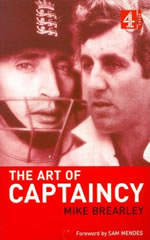The Art of Captaincy
Stuart Wark |Published: 2001
Pages: 296
Author: Brearley, Mike
Publisher: Channel 4
Rating: 4.5 stars

I grew up in the late 1970s and 1980s. I feel that my inherent sense of pessimism is a direct consequence of the regular, and ultimately traumatic, exposure to Australian cricket’s weakest era. I have a strong memory of a team that was consistently dominated by the West Indies and, unlikely as it seems now, even comprehensively thrashed by New Zealand. Even more disturbingly, the side had an amazing capacity to lose matches from seemingly dominant positions. Much of my still evident psychological distress can probably be traced back to the 1981 Ashes. While the performances of Ian Botham is intrinsically linked to these Tests, this series also played a significant role in establishing Mike Brearley’s reputation as a captain of the highest order. In 1985, Brearley released a book, The Art of Captaincy, which is still regarded as the seminal work on leadership. This reputation has remained unchallenged, as captaincy is one area of cricket that authors strangely have not dissected ad nauseum. The Art of Captaincy was re-released in 2001, and with the recent conclusion to the ICC Twenty20 World Cup, it seemed an appropriate time to review this work to see if it has remained current and applicable to cricket in the 21st century.
John Michael (Mike) Brearley was educated at the City of London School, which also can boast other famous former pupils including British Prime Minister Herbert Asquith and Daniel Radcliffe, the actor best known as playing Harry Potter. Brearley went to Cambridge and studied philosophy and the moral sciences. It was while he was still at Cambridge that Brearley’s captaincy potential was first noted, with his selection to lead an MCC Under 25 side to Pakistan. While he was recognised as a promising batsman and keeper during these early days, Brearley ultimately did not have a Test career that could be considered as successful purely in terms of on-field performances. He scored 1442 runs at an average of just 22.88 in 39 Tests; figures that could never be used to justify his place in the side. It was, however, his ability to manage players and lead teams that was his strongest point. In fact, he captained England in 31 of his 39 Tests, a remarkable ratio for a cricketer in the 20th Century.
Brearley had published a number of tour diaries in the late 1970s and early 80s, such as Phoenix from the Ashes, Ashes Retained, and The Ashes Returned, which were all co-written with Dudley Doust. However, he is best known for his book, The Art of Captaincy, which was first released in 1985. It is somewhat surprising for a game like cricket, in which the captain can play such a large role in the direction of the match, that there are so very few comprehensive books on captaincy. It is possible to argue that instinctive captains, such as Keith Miller, could not accurately detail how they led their teams (other than Miller’s wonderful approach to setting the field by telling his players to ‘scatter’), and that more conventional captains who led ‘by the book’ therefore had no new insights to share. Nonetheless, it seems strange that, prior to Brearley, there was very little literature on the topic.
The Art of Captaincy has stood up remarkable well to the test of time. Brearley’s background in academia is evident, with the text well written and easy to understand. The prose is both clear and elegant. He cannot be said to over-simplify matters though, and he accurately details how and why decisions are made. Much is made in the media of Brearley’s background as a psychoanalyst, and how this training was an essential component of his captaincy. As psychology is my own field of employ, I feel appropriately placed to describe this as complete rubbish and note that this belief actually downplays Brearley’s personal attributes. I know a lot of psychologists, and very few are what I would describe as captaincy material. Brearley clearly has an analytic mind, but he also must have the necessary personality to allow him to work well with many different types of people. The Art of Captaincy lays out many of the principles and concepts of leadership, and outlines how anyone can apply them. Training in psychology is optional, and definitely not essential.
On the downside, while the book was re-released in 2001, there appears to have been only a marginal attempt to update it. This is best underscored in the long treatise about the dying art of leg-spin, which is slightly off-putting when you consider that Shane Warne had been bowling out England without even trying for nearly a decade. There is also no mention of Twenty20, which is hardly surprising as the game wasn’t yet in the public consciousness. I do also feel, perhaps cynically as an Australian, that Brearley’s reputation as a captain extraordinaire is somewhat inflated by the fact that he carefully managed to avoid captaining England against the all-conquering West Indies, and also by the fact that people forget he led England to a 3-0 Test series loss in Australia in 1979/80. However, I accept that this viewpoint is probably more due to sour grapes than anything else, and none of this alters the overall value of this book.
In summary, this is a book well worth tracking down for anyone who is interested in cricket. While the topic is captaincy, it covers many different concepts and would appeal to anyone who loves the game. There have been few books on captaincy, good or otherwise. It is possible to consider that as Brearley did such a good job, no-one else has bothered to try and compete.






Leave a comment